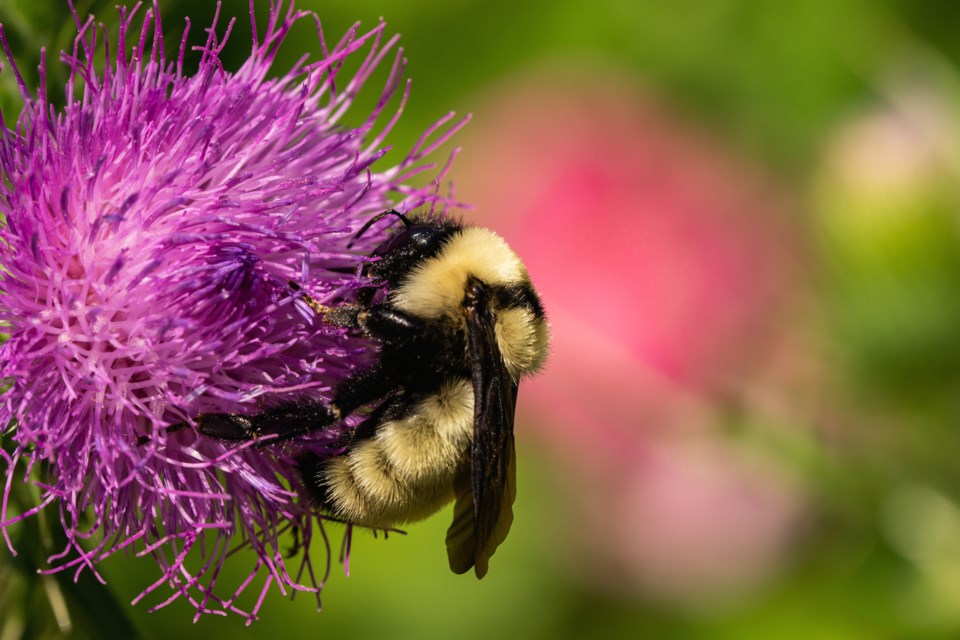NEWS RELEASE
UNIVERSITY OF GUELPH
*************************
Pesticides that have been marketed as “safe for honeybees” can still cause harm to wild ground-nesting bees, finds new research from the University of Guelph.
The study is one of the first to test the impacts of such insecticides and fungicides on wild solitary bees. It’s also the first to assess their impacts on ground-nesting species and the effects of pesticide exposure through soil – a route typically neglected in pesticide risk assessments.
In findings published in Proceedings of the Royal Society B: Biological Sciences, the research team from the Ontario Agricultural College found that wild squash bees exposed to the pesticides studied – alone or combined – experienced reduced pollen collection, hyperactivity or changes in reproduction.
This could have implications for squash bee populations and the crops they pollinate, including squash and pumpkin (cucurbits), and the broader array of animals and plants they interact with.
Insecticides marketed as “bee-safe” have emerged in recent years in response to growing concerns over neonicotinoids, a widely used class of insecticides known for neurotoxic effects on bees.
In light of their study’s results, School of Environmental Sciences researchers Dr. Nigel Raine and Dr. Sabrina Rondeau, who completed the study as part of her PhD, call for pesticide regulations and the “bee-safe” designation to be re-evaluated.
Majority of bee species at risk of pesticides in soil

One of the pesticides studied, flupyradifurone, an insecticide often sold under the name Sivanto Prime, has been deemed “practically non-toxic” to adult honeybees by the U.S. Environmental Protection Agency (EPA).
However, this designation may overlook the risks posed to ground-nesting bees, which have different exposure routes, the researchers say.
More than 70 per cent of all bee species nest underground and are at risk of being exposed to pesticide residues found in soil. But soil exposure is not considered in current pesticide risk assessments.
Rondeau, now a postdoctoral fellow at the University of Ottawa, explains, “Current risk assessments primarily focus on honeybees but not the distinct behaviours of wild bee species, like when they make contact with the soil where they nest. Unlike honeybees, many wild bee species spend a significant part of their lives underground.”
Combining pesticides increases risk
The study also highlights the risks of pesticides when they’re combined, says Raine.
“While some pesticides, like fungicides, may individually pose lower risks to bees, combined exposure with insecticides can result in synergistic effects, amplifying their overall impact,” he says.
The study examined the effects of chronic exposure to the insecticide flupyradifurone and a fungicide, a combination of azoxystrobin and difenoconazole sold under the name Quadris Top, on hoary squash bees. These solitary bees are exposed to pesticide residues in soil due to their underground nesting habits.
Flupyradifurone persists in soil, posing a particular risk to ground-nesting bees, the researchers say. The fungicide studied, commonly used on cucurbit crops, exacerbates this risk as its systemic nature also leads to pollen, nectar and soil contamination.
Rondeau notes, “Label guidelines don’t allow us to apply tank mixtures of these pesticides to flowering crops. But they can still each be used on the same crops during the same growing season, increasing the likelihood of co-exposure for bees.”
This research uncovered various adverse effects on ground-nesting squash bees: reduced pollen collection for bees that were exposed to the fungicide, and the production of larger offspring for bees exposed to the insecticide. When the pesticides were combined, the researchers saw hyperactivity induced in female squash bees.
These effects, while more subtle than those observed with highly toxic neonicotinoids, still pose significant risks to bee populations.
Pesticide regulations must be re-evaluated
Raine emphasizes the importance of comprehensive pesticide risk assessments that consider both acute and sublethal effects on ground-nesting bees and other wild bee species.
“With the phase-out of neonicotinoid insecticides,” he says, “there is a pressing need to fully evaluate the potential risks posed for all beneficial insects, including pollinators, by alternative pesticides that are replacing them.”
The findings of this study show the importance of re-evaluating pesticide regulations and promoting sustainable agricultural practices to safeguard pollinator populations and ecosystem health – so that one day, “bee-safe” will truly mean safe for all bees.
This work was supported by the Ontario Ministry of Environment and Climate Change (MOECC) Best in Science grant, Natural Sciences and Engineering Research Council (NSERC), and the Food from Thought: Agricultural Systems for a Healthy Planet Initiative, by the Canada First Research Excellence Fund.
Rondeau was supported by graduate scholarships from The Arrell Food Institute, the Fonds de recherche du Québec – Nature et technologies (FRQNT) and the Ontario Agricultural College (OAC). Raine is supported as the Rebanks Family Chair in Pollinator Conservation by the Weston Family Foundation.
*************************



